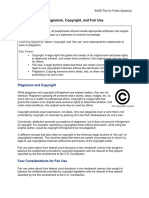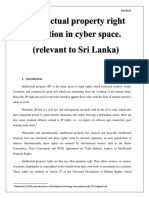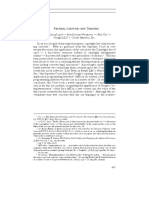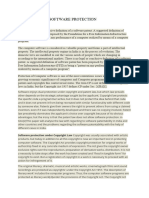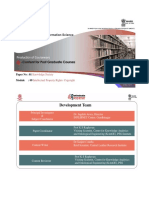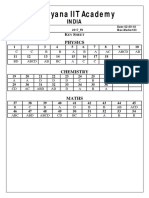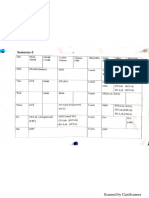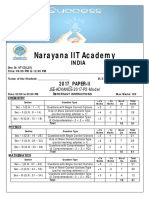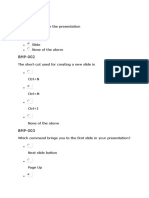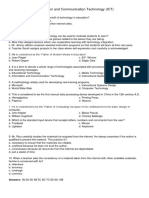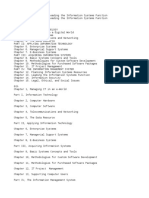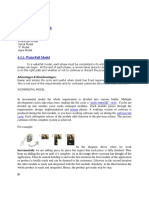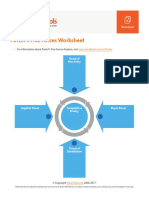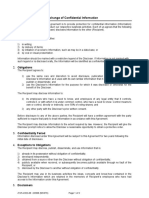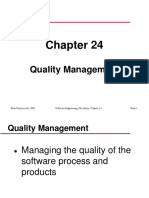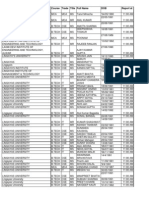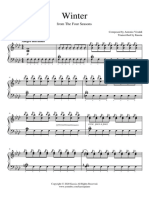Student, Shubham Singh, Intellectual Property Rights and Law (Dr.
Reeta Sony): Assignment 1
Intellectual Property Rights and Law: Assignment 1
Due on Saturday, 25 April 2020
Dr. Reeta Sony
Shubham Singh
Enrollment No. 19-11-EC-050
Student (1st year) B.tech (CSE)
School of Engineering
Jawaharlal Nehru University
1
�Student, Shubham Singh, Intellectual Property Rights and Law (Dr. Reeta Sony): Assignment 1
Contents
Problem 1…………………………………………………………………………… 3
Problem 2…………………………………………………………………………… 7
Bibliography…………………………………………………………………………10
2
�Student, Shubham Singh, Intellectual Property Rights and Law (Dr. Reeta Sony): Assignment 1
Problem 1 (Homework Problem 1)
Statement: What is ‘Fair Use’ in copyrights? Discuss the concept of fair use in computer
software.
Solution: Fair use is a copyright principle based on the belief that the public is entitled to use
portions of copyrighted materials for ‘transformative’ purposes like commentary,
research, teaching and criticism. Fair use developed as a doctrine in law of the
UNITED STATES that permitted the limited use of copyrighted material without
acquiring the permission of the copyright holder beforehand. Use of such material
if qualifies for fair use, cannot be considered infringement. The doctrine tries to
bring balance to the rights of copyright owners and society’s interests in allowing
copying in some cases, particularly in socially important endeavors which may
include, but are not limited to research, teaching, news reporting, criticism. The
judiciary created doctrine is now set forth as a law in the Copyright Act of U.S.
According to the above-mentioned law, the ‘fairness’ in fair use is to be determined
by considering the following factors:
1. the purpose and character of the use, including whether such use is of a
commercial nature or is for non-profit educational purposes;
2. the nature of the copyrighted work;
3. the amount and substantiality of the portion used in relation to the
copyrighted work as a whole; and
4. the effect of the use upon the potential market for or value of the
copyrighted work.
3
�Student, Shubham Singh, Intellectual Property Rights and Law (Dr. Reeta Sony): Assignment 1
The first factor concerns with the ‘transformative’ nature of your purpose and use
and its degree of transformation, the second deals with the very nature of the
copyright work – is it fictional or non-fictional, is it published or unpublished?
The third factor which deals with ‘amount’ of the original work is based around the
rule—less is more—the lesser one borrows, the more likely is that his copying will
be excused as ‘fair use’. However, taking less is not considered an excuse when the
‘portion’ taken is the heart of the work. This rule—less is more—on the contrary
is not true in parody cases, even if the parodist borrows the heart of the work. That’s
because as the U.S. Supreme Court has acknowledged, “the heart is also what most
readily conjures up the [original] for parody, and it is the heart at which parody
takes aim.” The fourth factor of fair use ensures that the ‘fair use’ does not deprive
the copyright owner of income or undermines a potential market for the
copyrighted work. In this regard (and with regard to impact on the market),
different works involve different fair use analysis.
It is important to mention here that although the doctrine is now a part of U.S. law,
similar concepts have developed independently in other parts of the world, the most
highlighted example begin U.K where a similar concept of ‘Fair Dealing’ has
evolved.
Copy right and its implications on computer software is a relatively new
phenomenon. Newer is the fair-use interpretations of the application of copyright
law on computer software (proprietary, copyleft or open source). Much of this
interpretation is built upon Sega Enterprises Ltd. v. Accolade, Inc., (9th
Circuit,1992) and Lewis Galoob Toys, Inc. v. Nintendo of America, Inc (9th Circuit
Court of Appeals, 1992) in the United States
4
�Student, Shubham Singh, Intellectual Property Rights and Law (Dr. Reeta Sony): Assignment 1
In Galoob v. Nintendo, the 9th Circuit held that modification of copyrighted
software for personal use was fair. In Sega v. Accolade, the 9th Circuit held that
making copies in the course of reverse engineering is fair use, “ where disassembly
is the only way to gain access to the ideas and functional elements embodied in a
copyrighted computer program and where there is a legitimate reason for seeking
such access,…” . The U.S. law also states that it is compulsory to destroy archival
copies of software, when the license should expire.
The ‘fair use’—in actual the ‘fair dealing’ exceptions, for India, with respect to
computer software programs have been enumerated through the Copyrights Act,
1957 and the Amending Acts of 1994 and 1999. The concept of ‘fair use’ (similar
to ‘fair dealing’) is a rather new concept in India with respect to number of cases
as well as difference in the question of law, the boundaries of which are yet to be
determined by the jurisdiction the Indian courts evolve. For example, unlike U.S.
law, Indian law is silent on the matter whether archival copies of copyrighted
software should be destroyed or not after the license has expired.
The most recent case raising the question of ‘fair use’ in computer software is the
Google V. Oracle America case. The dispute is about the ownership and
implementation of APIs. APIs allow different computers to communicate with each
other, specifying how information is processed, transformed and shared. Oracle’s
initial claim was that Google infringed on its copyright by copying its APIs inviting
a counter from Google stating that no one owns it. The APIs in question were
developed by Sun Microsystems in Java language in 2006. Oracle acquired Sun
Microsystems in 2009 and says that it owns that code, which Google copied when
it created the Android mobile operating system. Google however says that APIs
5
�Student, Shubham Singh, Intellectual Property Rights and Law (Dr. Reeta Sony): Assignment 1
can’t be copyrighted because they aren’t original expressions protected by
Intellectual property Law. Instead APIs are ‘useful arts’ as stated by Google while
comparing this case with Baker v. Selden, 1890. Google also argues that even if the
APIs are copyrightable software, its implementation falls under the ‘fair use’
exception. The computer scientists, a group of 73 pioneering figures in the industry,
who signed an amicus argue that, “treating software interfaces as copyrightable
would be like requiring car manufacturers to invent a substitute for steering wheel.”
Google’s suggestion that even if the APIs are copyrightable, any copyright (here)
should be so thin that ‘fair use’ would readily apply in most cases. This argument
which has already been disregarded by the lower courts, if is put down by the
appeal court would, “reject what the lower courts have been doing in the 25 years”
in the issues of fair use. The case will now be argued in October or November 2020
with a decision likely in 2021.
The Google v. Oracle case, which possibly is the biggest patent case of 2020—
even though it raises no patent questions—garners a potential reputation like the
Sega v. Accolade/Galoob v. Nintendo cases or maybe even greater in determining
the concepts and boundaries of fair use in computer software. Whatever the
outcome, it will be one of the most important cases in determining the applicability
of the fair use concept in regards to computer software.
6
�Student, Shubham Singh, Intellectual Property Rights and Law (Dr. Reeta Sony): Assignment 1
Problem 2 (Homework Problem 3)
Statement: Explain the role of IPR in the protection of Biotechnology.
Solution: Biotechnology is a field which uses natural frameworks to develop genetic
resources of/related to biodiversity. Being interconnected with most disciplines, it
boasts an infinite potential for innovation and hence requires a form of protection
to keep the knowledge safe and preserved. This protection is achieved by holding
the Intellectual Property Rights as the shield. Aspects of IPR involved in
biotechnology are:
• Patents
• Plant Breeder’s Rights and Farmer’s Variety Act:
• Trademark
• Copyrights
• Trade Secrets
It is important to note that even if there are no specific legislations to protect some
kinds of Intellectual Properties falling under this category in India, separate IPR
have been designed to protect them. For example, the Plant Breeder’s Rights has
been designed to protect plant varieties. Similarly, software is not patentable in
India, and Bioinformatics comprises of this drug designing software. Copyrights
help in providing protection for this.
The research and innovations in the field of biotechnology are instrumental in
health care systems, agriculture industry, pharmaceutical sector, polymers and
materials sectors, etc. Research and development in this area is highly time and
7
�Student, Shubham Singh, Intellectual Property Rights and Law (Dr. Reeta Sony): Assignment 1
capital consuming with risks involved with the outcome. To promote such results,
it is quite important to patent the inventions in the said field.
Various legislations/mechanisms in place in India for the protection of IPRs
involving biotechnology are:
1. Section 3(d) of the Patents Act, 1970
2. Section 3(i) of the Indian Patent Act
3. Instructions for Technology Transfer and Intellectual Property Rights
issued by the Ministry of Science and Technology
4. Science and Technology Policy-2003 of the Indian Government
Also, in order to help the patent seekers, a Biotechnology Patent Facilitation Cell
(BPFC)2 was established by the Department of Biotechnology (DBT) in July'1999.
BPFC has been catering to the need of promotion of biotech research by:
1. Creating awareness and understanding among biologists and
biotechnologists, relating to patents and the challenges and opportunities in
this area
2. Providing patenting facilities to biologists and biotechnologists in the
country for filing Indian and foreign patents on a sustained basis.
3. Keeping a watch on development in the area of IPR and make important
issues known to policymakers, bio-scientists, biotech industry, etc
Overtime many critics who are against the idea of patenting the developments
in the field of Biotechnology have emerged. However, they have failed to
recognise that, ““The negative impact of patents has been justified on the
8
�Student, Shubham Singh, Intellectual Property Rights and Law (Dr. Reeta Sony): Assignment 1
grounds that they are the only instrument that can adequately protect
investments in research and development for new medical technologies. This
assumption is false and a wide range of public policy instruments … are either
currently in use, or have been proposed, to stimulate research and development
for new medical products,” as said by Knowledge Ecology International in its
amicus curiae brief on the Association for Molecular Pathology v. Myraid
Genetics case.
International Protection in the said field is also an issue today. Obtaining
worldwide protection is difficult since most countries do not honour the patent
system. Surprisingly, countries without a solid patents system (such as India,
China, Argentina) are not troublesome to the biotech industry; countries with
such systems in place are.
Conclusively Intellectual Property Rights play an important role in the
protection of Biotechnology—not only directly by the means of copyrights,
patents, trademarks and special legislations/policies/guidelines but also
indirectly by creating incentives (by inviting investments) and motivation
among researchers. This role of protection of Biotechnology by the means of
IPR has now become an important aspect in ensuring the future growth and
innovations in this field.
9
�Student, Shubham Singh, Intellectual Property Rights and Law (Dr. Reeta Sony): Assignment 1
Bibliography
1) Ward-Ure, L. (2018, August 09). Copyright Uncovered: Fair Use v Fair Dealing. DACS
News. Retrieved from: https://www.dacs.org.uk/latest-news/copyright-uncovered-
%E2%80%93-q3-2018-fair-use-v-fair-deal?category=For+Artists&title=N.
2) Fair Use. (n.d.). In Wikipedia. Retrieved April 23 2020, from:
https://en.wikipedia.org/wiki/Fair_use
3) Fair Dealing. (n.d.). In Wikipedia. Retrieved April 23 2020 from:
https://en.wikipedia.org/wiki/Fair_dealing
4) Fair Use. (n.d.), fairuse.stanford.edu : SUL Copyright and Fair Use, Retrieved 23 April
2020, from: https://fairuse.stanford.edu/overview/fair-use/
5) Fair Use in Copyright Law. (n.d.). bitlaw.com: A free legal resource on Intellectual
Property. Retrieved 23 April 2020, from: https://www.bitlaw.com/copyright/fair_use.html
6) Copyright Act (17 U.S.C.) INDEX. (n.d.). bitlaw.com: A free legal resource on Intellectual
Property. Retrieved 23 April 2020, from:
https://www.bitlaw.com/source/17usc/index.html#Chapter_1
7) Cases referred:
i) https://www.copyright.gov/fair-use/summaries/campbell-acuff-1994.pdf
ii) https://www.copyright.gov/fair-use/summaries/fisher-dees-9thcir1986.pdf
8) Software Copyright. (n.d.), In Wikipedia. Retrieved April 23, 2020 from:
https://en.wikipedia.org/wiki/Software_copyright#Fair_use
9) Lewis Galoob Toys, Inc. v. Nintendo of America, Inc. (n.d.), In Wikipedia. Retrieved
April 23, 2020 from:
https://en.wikipedia.org/wiki/Lewis_Galoob_Toys,_Inc._v._Nintendo_of_America,_Inc.
10
�Student, Shubham Singh, Intellectual Property Rights and Law (Dr. Reeta Sony): Assignment 1
10) Sega v. Accolade. (n.d.), In Wikipedia. Retrieved April 23, 2020 from:
https://en.wikipedia.org/wiki/Sega_v._Accolade
11) Google v. Oracle America. (n.d.), In Wikipedia. Retrieved April 23, 2020 from:
https://en.wikipedia.org/wiki/Google_v._Oracle_America
12) Livni, E. (2019, November 20). US Supreme Court holds innovation in the balance in
Google v. Oracle. Quartz. Retrieved from: https://qz.com/1751975/in-google-v-oracle-scotus-
holds-innovation-in-the-balance/
13) Copyright. (n.d.), meity.gov.in. Retrieved April 23, 2020 from:
https://meity.gov.in/content/copyright
14) Sharma, C. (2015, April 18). Role of IPR in Biotechnology Industry. Retrieved from:
https://www.iipta.com/role-of-ipr-in-biotechnology-industry/
15) Saez, C. (2013, February 02). Monsanto, Myraid: Two US Legal Cases Shaking Biotech
Industries. Intellectual Property Watch. Retrieved from: https://www.ip-
watch.org/2013/02/18/monsanto-myriad-two-us-legal-cases-shaking-biotechnology-industries/
16) Rastogi, P. (2016, July 04). India: Protection of Biotechnology Under Indian Laws.
Mondaq. Retrieved from: https://www.mondaq.com/india/patent/506468/protection-of-
biotechnology-under-indian-laws
17) National Research Council. 1993. Global Dimensions of Intellectual Property Rights in
Science and Technology. Washington, DC: The National Academies Press. Retrieved
from: https://doi.org/10.17226/2054.
11
















